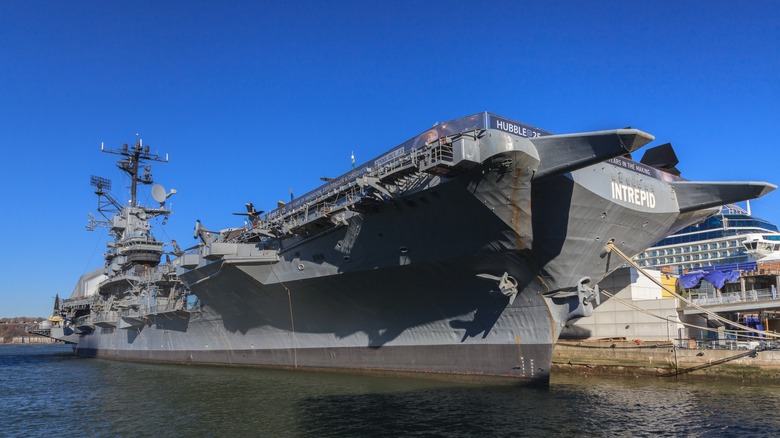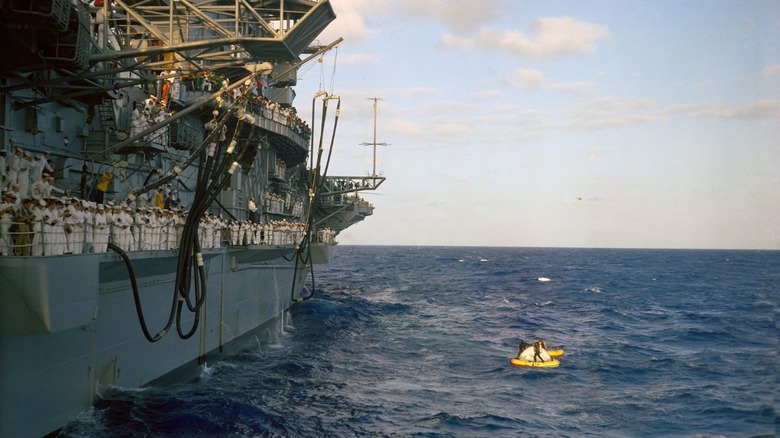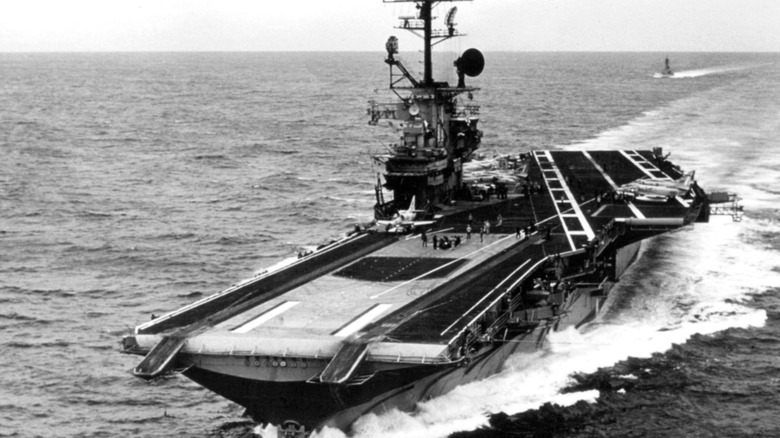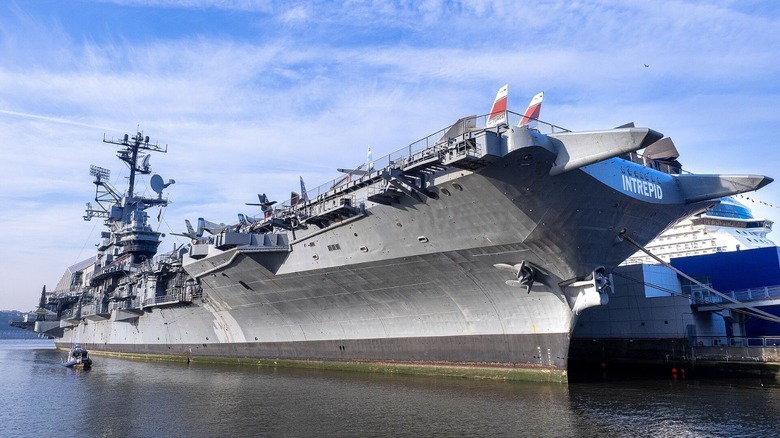Where Is The USS Intrepid Now & Why Is This Aircraft Carrier Famous?
Laid down on December 1, 1941, and commissioned on August 16, 1943, the Essex-class aircraft carrier USS Intrepid was one of 24 of its kind built during World War II. Having been launched so late in the war, Intrepid, also known as the Fighting "I," missed out on pivotal maneuvers like the brilliant victory over the Imperial Japanese Navy at Midway. She did, however, participate in the largest naval battle ever at Leyte Gulf as part of the Philippines campaign, assisted in the invasion of Okinawa island, sank the otherwise unsinkable Japanese battleship Musashi, and sustained several kamikaze attacks in the process.
A few scraps at Wake Island and Eniwetok added to Intrepid's service history, which included sinking two Japanese battleships, but she otherwise didn't see the same degree of conflict before the war's end as her sister ships — USS Enterprise, Yorktown, and Hornet, all of which were at the tide-changing Battle of Midway. Still, the Fighting "I" made a name for herself throughout her entire service, even after she was converted into an attack carrier post-war.
The Intrepid had a fairly long service history. She served in the U.S. Navy for just over 30 years, participating in World War II and the Vietnam War before being berthed at Pier 86 in New York's Hudson River, where she remains today. While her active time at war could be enough to earn her notoriety, Intrepid has been part of fascinating moments in history to warrant her fame today.
The USS Intrepid aids a NASA spaceflight
On May 24, 1962, NASA launched Mercury-Atlas 7, the fourth flight of NASA's first human spaceflight program. Piloted by Scott Carpenter, the Aurora 7 was scheduled to circle the Earth three times over five hours and perform a series of experiments. At the conclusion of the mission, Carpenter and the Aurora 7 had a projected landing trajectory, which was missed by approximately 250 nautical miles. Though the USS Farragut was the first vessel to reach the displaced capsule and its pilot, it was the USS Intrepid, then designated an antisubmarine carrier, that deployed the helicopters that rescued Carpenter and his capsule, Gemini 3, from the water.
Only marginally relevant to anyone who wasn't really following NASA's spaceflight programs, serving as transport for the Aurora 7's pilot was merely a precursor to the unexpected fame Intrepid would garner after its decommissioning 12 years later. If there was to be anything more American than participating in the 1960s space race, it would be hosting a rematch of the United States versus Japan.
[Featured image by NASA via Wikimedia Commons | Cropped and scaled | CC BY-SA 3.0]
The WWE comes to the USS Intrepid
For years, Hulk Hogan was the patriotic face of the WWE (then still known as the WWF). His first retirement in 1992, however, put Vince McMahon in a bind to try and find a presence that could rival the "Real American." It became even more important when then-WWF villain, pseudo-Japanese wrestler Yokozuna, challenged anyone in the current roster to body slam him aboard the USS Intrepid on the Fourth of July. Though Yokozuna wasn't actually Japanese, his persona fit the billing of a sumo wrestler, and the challenge seemed fitting for the carrier that once combatted the Imperial Japanese Navy.
On the day of the challenge, as Yokozuna promised, he awaited the arrival of the WWF's next potential champion. It was a media spectacle that drew a packed crowd to the carrier as greats like Macho Man Randy Savage failed to lift the heavyweight from the mat. Then arrived Lex Luger, who swooped in on a helicopter, spouted off a patriotic speech, then did what others couldn't and body-slammed his 500-lb opponent. The Intrepid had again played host to a "Japanese" and American conflict, from which the U.S. emerged victorious.
[Featured image by U.S. Navy via Wikimedia Commons | Cropped and scaled | CC BY-SA 3.0]
Visiting the USS Intrepid
As mentioned, the USS Intrepid is currently berthed in the Hudson River. Unlike some decommissioned warships, though, visitors have the opportunity to step aboard the World War II carrier. As part of the Intrepid Museum's permanent installation, the former aircraft carrier accommodates visitors looking to get a closer look at the mighty warships of the U.S. Navy, further explore the Intrepid's history, and learn more about the impressive aircraft that once launched from the carrier's deck.
Visitors will have access to four of Intrepid's levels, including the flight, gallery, hangar, and third decks. The Hangar Deck offers the Exploreum, an interactive exhibit that allows guests to see the inside of a Bell 47 helicopter, learn how sailors lived aboard carriers, and explore the interior of a submarine. The Intrepid Museum also features access to the nation's only publicly accessible nuclear missile submarine, the Growler, a British Airways Concorde, and a prototype NASA orbiter.
[Featured image by NASA via Wikimedia Commons | Cropped and scaled | CC BY-SA 3.0]



